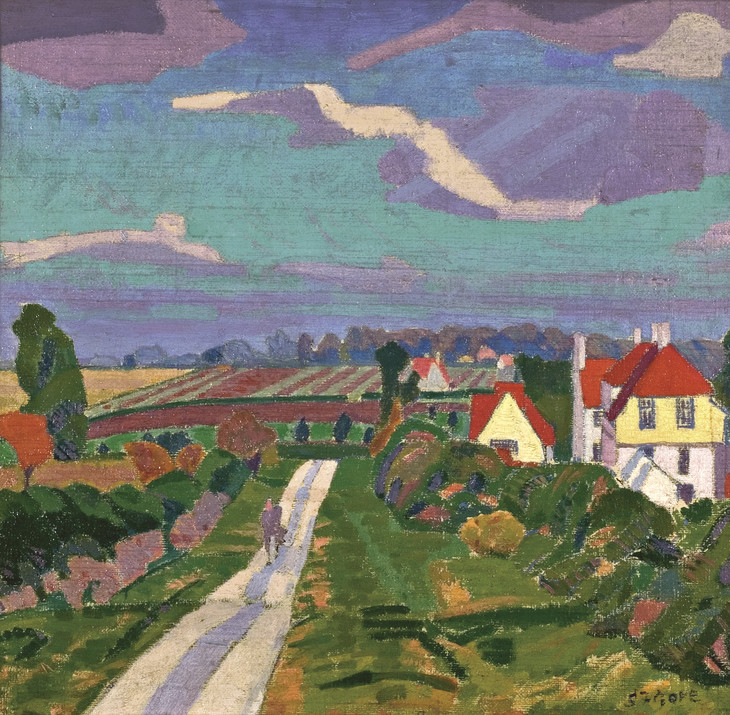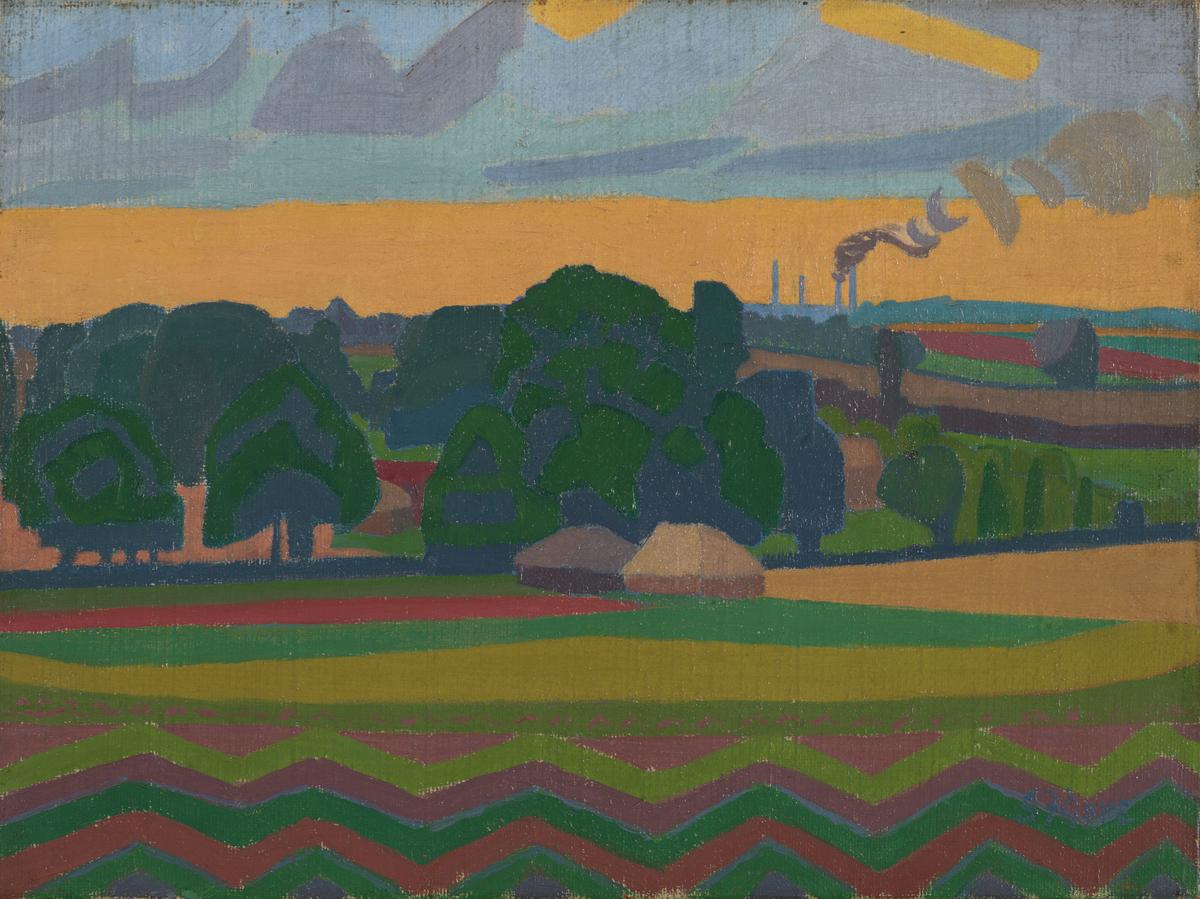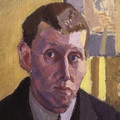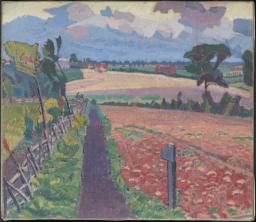Spencer Gore The Beanfield, Letchworth 1912
Spencer Gore,
The Beanfield, Letchworth
1912
One of Gore’s most stylised paintings, it uses flat and vivid colour to abbreviate form and give distinctive angular patterns to the landscape, especially in the foreground zig-zag bordering the field of beans behind. Gore developed his style dramatically during his stay in Letchworth Garden City from August to November 1912. Trees in full leaf and a golden yellow sky indicate high summer or early autumn; on the distant horizon, the puffing chimneys of the Arlesey brickworks are visible.
Spencer Gore 1878–1914
The Beanfield, Letchworth
1912
Oil paint on canvas
305 x 410 mm
Inscribed by the artist ‘S.F. GORE’ in blue paint bottom right; inscribed by Harold Gilman ‘Painted at Letchworth, Herts by SF Gore | in 1912. The colours found in the material | objects (field of beans for instance in foreground) | is collected into patterns. This was his own | explanation. Signed SF Gore | (154) a’ in ink on label on bottom member of canvas stretcher; ‘58’ and ‘154’ in chalk on back.
Purchased (Grant-in-Aid) 1974
T01859
1912
Oil paint on canvas
305 x 410 mm
Inscribed by the artist ‘S.F. GORE’ in blue paint bottom right; inscribed by Harold Gilman ‘Painted at Letchworth, Herts by SF Gore | in 1912. The colours found in the material | objects (field of beans for instance in foreground) | is collected into patterns. This was his own | explanation. Signed SF Gore | (154) a’ in ink on label on bottom member of canvas stretcher; ‘58’ and ‘154’ in chalk on back.
Purchased (Grant-in-Aid) 1974
T01859
Ownership history
Mrs Mary Johanna Gore, the artist’s widow; by descent to Frederick Gore and Elizabeth Cowie, the artist’s children; bought through Anthony d’Offay Gallery, London, by Tate Gallery 1974.
Exhibition history
1913
Paintings by Spencer F. Gore and Harold Gilman, Carfax Gallery, London, January 1913 (26, as ‘The Beanfield’, 12 guineas).
1962
Spencer Gore and Frederick Gore, Redfern Gallery, London, February–March 1962 (58).
1967
The Camden Town Group and English Painting 1900–1930’s, William Ware Gallery, London, March 1967 (82, as ‘The Beanfield’).
1970
Spencer Gore 1878–1914, The Minories, Colchester, March–April 1970, Ashmolean Museum, Oxford, April 1970, Graves Art Gallery, Sheffield, May–June 1970 (46).
1974
Spencer Frederick Gore 1878–1914, Anthony d’Offay Gallery, London, March–May 1974 (24).
2006
Spencer Gore in Letchworth, Letchworth Museum and Art Gallery, September–October 2006 (9, reproduced).
2008
Modern Painters: The Camden Town Group, Tate Britain, London, February–May 2008 (73, reproduced).
2008–9
A Countryman in Town: Robert Bevan and the Cumberland Market Group, Southampton City Art Gallery, September–December 2008, Abbot Hall Art Gallery, Kendal, January–March 2009 (no number, reproduced pl.30).
References
1974
John Woodeson, ‘Spencer Gore’, Connoisseur, vol.185, no.745, March 1974, p.174, reproduced.
1975
Tate Gallery Report 1972–4, London 1975, pp.157–8, reproduced p.156.
1976
Richard Cork, Vorticism and Abstract Art in the First Machine Age, vol.1, London 1976, p.21, reproduced.
1974
Guardian, 30 March 1974, reproduced.
1979
Wendy Baron, The Camden Town Group, London 1979, pp.42, 48–9, 292, 294, 374, reproduced pl.112.
1980
Simon Watney, English Post-Impressionism, London 1980, p.121, reproduced fig.110.
2000
Wendy Baron, Perfect Moderns: A History of the Camden Town Group, Aldershot and Vermont 2000, pp.55, 56, 130–2, 181, reproduced p.131.
2002
Ysanne Holt, ‘An Ideal Modernity: Spencer Gore at Letchworth’, in David Peters Corbett, Ysanne Holt and Fiona Russell (eds.), The Geographies of Englishness: Landscape and the National Past, 1880–1940, New Haven and London 2002, pp.102–3, reproduced fig.40 and on cover.
2006
Adrian Glew, ‘Every Work of Art is the Child of its Time, Often it is the Mother of our Emotions’, Tate Etc., no.7, Summer 2006, p.42, reproduced p.40.
Technique and condition
The Beanfield, Letchworth is painted in artists’ oil paints on primed stretched canvas. The coarse cloth is made of thin flax (linen) and thick hemp threads and has a plain weave. It has been sized and double primed. The priming has been evenly applied and retains the canvas weave texture. Its basic composition conforms to other double primers identified on Gore’s paintings (see also Tate N04675), except for the inclusion of synthetic blue ultramarine in the lower layer. This relates to Gore’s preoccupation with the whiteness of his preparatory surface. The pigment produced a cooler white with a bluish cast and was thought to reduce the yellowing of oil, thus helping to preserve the whiteness of the priming. A similar preparation is also found on Charles Ginner’s Victoria Embankment Gardens also 1912 (Tate T03841), perhaps indicating a link in the two artists’ practice at this time.
The compositional forms were initially drawn in blue paint, traces of which are visible at the unpainted edges (see also Tate T02260). Each discrete shape is coloured with one or more layers of paint, which was of a stiff paste-like consistency when applied. The opaque paint is applied dry-on-dry, covering the underlying paint and modifying the colour. Underlying colours and small areas of priming are deliberately left visible at the edges of shapes, demarcating formal boundaries.
Light shadow and half tones are applied wet-in-wet, for example the foliage of the dark trees in the middle distance with their blue-green shadows. This technique softens the brushwork so as not to create a hard edge, and thus not create a ‘boundary’. It also creates a physical and optical colour mixture at the surface, whereas the dry-on-dry application retained the purity of the colour. Colours and tones are uniformly saturated by a coating of varnish, which covers the whole of the painted surface. It is not known whether this varnish is original.
Roy Perry and Sarah Morgan
August 2004
How to cite
Roy Perry and Sarah Morgan, 'Technique and Condition', August 2004, in Robert Upstone, ‘The Beanfield, Letchworth 1912 by Spencer Gore’, catalogue entry, May 2009, in Helena Bonett, Ysanne Holt, Jennifer Mundy (eds.), The Camden Town Group in Context, Tate Research Publication, May 2012, https://wwwEntry
This is one of the most stylised pictures that Gore made, in which he has abbreviated the forms and contours of the countryside into angular shapes and patterns, painted in vivid, flat areas of colour. Gore’s fellow Camden Town Group member James Bolivar Manson wrote about the catharsis Gore seems to have undergone while staying at Harold Gilman’s home in Letchworth Garden City from August to November 1912, and his abandonment of pure impressionism:
About 1912 Gore went to Letchworth. He had become conscious of the need for development in his art. He needed change. He seems to have felt something of the same dissatisfaction with Impressionism that Cézanne felt; its lack of definition and solidity. The feeling was intrinsic; it was not a pressure from outside. Already he had led up to the change by a definite organisation of his colour expression. He began to simplify and to mass the colour schemes of his pictures, grouping the tones into hot and cold colour. There was a gain in strength, solidity, and pattern; there was some loss of atmosphere and sparkle.
At Letchworth he made a desperate break. He began to analyse his colour tones very broadly, and to put them down in arbitrarily defined masses; his drawing became simpler, more massive, angular. It was a period of transition and the paintings of the time revealed the working of his mind in a very interesting way.1
Gilman recorded Gore’s own explanation of his approach to The Beanfield. A label on the bottom member of the stretcher has been inscribed in ink by Gilman: ‘Painted at Letchworth, Herts by SF Gore | in 1912. The colours found in the material | objects (field of beans for instance in foreground) | is collected into patterns. This was his own | explanation. Signed SF Gore | (154) a’. The back of the canvas is marked in chalk ‘58’ and ‘154’. Through simplifying areas into patterns and blocks of colour, Gore shows the landscape’s underlying form, as he wrote in 1910:
Simplification of nature necessitates an exact knowledge of the complications of the forms simplified. This may be done to produce a greater truth to nature as well as for decorative effect ... if the emotional significance which lies in things can be expressed in painting the way to it must lie through the outward character of the object painted.2
The patterning found in the fields and the sky is also accentuated in other works from this visit, such as Letchworth, The Road 1912 (fig.1).

Spencer Gore 1878–1914
Letchworth, The Road 1912
Oil paint on canvas
406 x 432 mm
Letchworth Museum and Art Gallery
Photo © Letchworth Museum and Art Gallery (North Hertfordshire Museum Service)
Fig.1
Spencer Gore
Letchworth, The Road 1912
Letchworth Museum and Art Gallery
Photo © Letchworth Museum and Art Gallery (North Hertfordshire Museum Service)
In The Beanfield Gore shows a view looking north-north-west from Letchworth, with the chimneys of Arlesey brickworks visible on the horizon. Gore’s viewpoint must have been from near the ridge on which the large Fairfield asylum is sited, a mile or so from where he was staying at 100 Wilbury Road. Brick-making was a significant part of the local economy, utilising deposits of clay that were found there. The Arlesey brick works was originally built by Robert Beart of Godmanchester in 1852. With a siding from the Great Northern railway line, production boomed and Beart was able to create a national market, sending bricks to build the expanding cities of the north and London, where an office was opened in King’s Cross. Production was highly mechanised, with clay forced under pressure into brick-making machines, and then dried quickly in stoves to produce bricks in vast numbers; in 1858 Arlesey was making 8,000,000 bricks a year, and 1,000,000 agricultural drainage pipes.3 By 1877 the clay pit at Arlesey was 60 feet deep.4 From the late 1860s two other companies were producing bricks at Arlesey, the Great Northern Railway, temporarily making bricks for the line’s viaducts and tunnels until they were complete, and then the Arlesey Brick Company, which merged with Bearts in about 1898. In 1928 Bearts was bought by London Brick and Forders Ltd. The works ceased production in about 1932, which may be the date of a dramatic photograph showing the chimneys falling as they are demolished.5 Gore’s inclusion of industry in an agrarian landscape points towards a peaceful coexistence between the worlds of nature and manufacture, a modern vision in keeping with Ebenezer Howard’s concept of Letchworth.6
The land in the foreground is probably that farmed at the time by Mr Jonah Ingrey of Standalone Farm. Ingrey’s ledger for the period 1912–18 now belongs to the First Garden City Museum, Letchworth. It records that he grew beans, selling his crop to the Country Gentlemen’s Association in September 1917 for £79.10s, and again in September 1918 for £399.7s.6d, a considerable sum of money which both implies a very large crop from a large acreage, and also the premium during the hungry years of the Great War. Due to the prevailing soil conditions around Letchworth, cereals were the major local crop along with potatoes and Brussels sprouts. Dairy farming became important as the town grew, but beans do not generally appear to have been grown very much locally.7 However, clay soils are favourable for bean growing, and the evidence of the brick industry here, which would have been reliant on clay for manufacture, demonstrates that the soil was clay-based and that this was why they were grown in this particular spot. Ingrey’s ledger refers to his crop as ‘W. Beans’, by which he probably meant ‘white beans’. These were probably field beans – Faba vulgaris arvensis – a type of broad bean commonly used for cattle fodder.8
One of the most notable elements of Gore’s picture is the richly coloured zig-zag which runs along the bottom part of the canvas. This is generally assumed, because it seizes the eye, to be the beanfield of the picture’s title. But this is in fact far from likely, and it is hard to be absolutely certain what it does represent. Beans were invariably planted in straight rows to facilitate ease of harvesting, never in zig-zags. One possibility is that the picture shows the undulating lines of plough furrows on an uneven, hilly surface, but this can probably be discounted because of the evidence of the trees in full leaf. This is a late summer scene, probably painted between August and September; ploughing would have taken place slightly later, or else the beans would have still been in place, fully grown, prior to their harvest in September, and furrows would not have been visible. It would seem additionally unlikely also that a piece of ground could be so uneven to produce furrows that undulate so much.
In a letter dated 25 January 1991, John Creasey of the Institute of Agricultural History and Museum of English Rural Life, University of Reading, stated that he had consulted a retired farm labourer from Hertfordshire, Mr Bill Petch, who suggested that the rick on the left of the painting is probably a bean rick waiting to be threshed after the autumn harvest, and that it is the field in the middle-distance, at the centre of the composition in front of the ricks, that is the beanfield of the title, not the zig-zag. He identified the rick on the right as probably being a newly thatched corn rick, and discounted the possibility of the zig-zag being anything to do with beans.
The zig-zag could perhaps be a winding path between two hedges, although this would perhaps create an untenable and contradictory perspective, or it could be a hedge itself, or perhaps some form of hurdle fence. That it is a type of decorative border can probably be discounted when one considers Gore’s general topographical veracity, and the fact that he did not employ such a device in any other picture. It is difficult, however, to ascertain with any degree of certainty precisely what element of the landscape Gore represents here.
There is a pastel study for this work, executed on the spot, in the possession of the artist’s family.
Robert Upstone
May 2009
Notes
James Bolivar Manson, ‘Preface’, in Exhibition of Paintings by Spencer F. Gore, exhibition catalogue, Leicester Galleries, London 1928, pp.7–8.
Spencer Frederick Gore, ‘Cézanne, Gauguin, Van Gogh &c., at the Grafton Galleries’, Art News, 15 December 1910, p.19.
See Ysanne Holt, ‘An Ideal Modernity: Spencer Gore at Letchworth’, in David Peters Corbett, Ysanne Holt and Fiona Russell (eds.), The Geographies of Englishness: Landscape and the National Past 1880–1940, New Haven and London 2002, p.103.
Information sent to the author by Robert Lancaster, First Garden City Heritage Museum, Letchworth, 8 January 1991.
Related biographies
Related essays
- City Visions: The Urban Scene in Camden Town Group and Ashcan School Painting David Peters Corbett
- The Camden Town Group and Early Twentieth-Century Ruralism Ysanne Holt
- The Evolution of Painting Technique among Camden Town Group Artists Stephen Hackney
Related catalogue entries
Related reviews and articles
- Spencer Gore, ‘Cézanne, Gauguin, Van Gogh &c., at the Grafton Galleries’ The Art News, 15 December 1910, pp.19–20.
How to cite
Robert Upstone, ‘The Beanfield, Letchworth 1912 by Spencer Gore’, catalogue entry, May 2009, in Helena Bonett, Ysanne Holt, Jennifer Mundy (eds.), The Camden Town Group in Context, Tate Research Publication, May 2012, https://www





